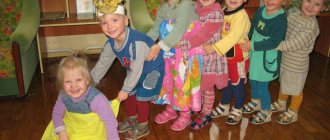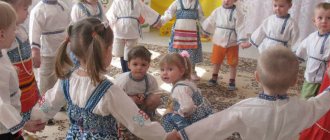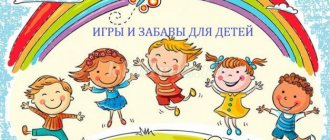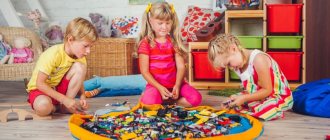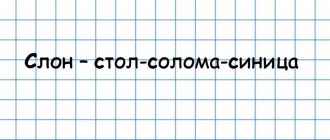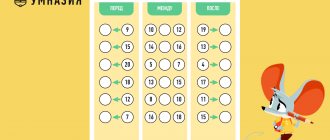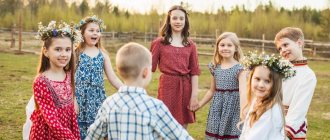Card index of outdoor games for older children
Elena Tsyganok
Card index of outdoor games for older children
Card index of outdoor games for older children
Outdoor game "Sly Fox"
Goal: To develop endurance and observation in children. Practice running quickly with dodging, lining up in a circle, and catching.
Description: The players stand in a circle at a distance of one step from each other. The fox's house is outlined outside the circle. The teacher invites the players to close their eyes, walks around the circle behind the children and says, “I’m going to look for a cunning and red fox in the forest!”
, touches one of the players, who becomes a sly fox.
Then the teacher invites the players to open their eyes and carefully look to see which of them is the sly fox, and whether she will give herself away in some way. The players ask in chorus 3 times, first quietly, and then louder, “Sly fox, where are you?”
.
At the same time, everyone looks at each other. The sly fox quickly goes to the middle of the circle, raises his hand up, and says “I’m here
. All the players scatter around the site, and the fox catches them. The caught fox takes him home to his hole.
Rules: The fox begins to catch children only after the players ask in chorus 3 times and the fox says “I’m here!”
If the fox gave himself away earlier, the teacher appoints a new fox.
A player who runs out of bounds of the court is considered caught.
Options: 2 foxes are selected.
Outdoor game “Pass - stand up”
Goal: To foster a sense of camaraderie in children , develop dexterity and attention. Strengthen the muscles of the shoulders and back.
Description: The players line up in two columns, two steps apart from each other. In each they stand at arm's length from each other. A line is drawn in front of the columns. Two balls are placed on it. At the signal to sit down
everyone sits down cross-legged.
At the signal “pass,”
the first in the columns take the balls and pass them over their heads to those sitting behind them, then they stand up and turn to face the column. The person who received the ball passes it back over his head, then stands up and also turns to face the column, etc. The column that passed the ball correctly and did not drop the ball wins.
Rules: Pass the ball only over your head and while sitting. Stand up only after passing the ball to the person sitting behind you. The one who fails to receive the ball runs after it, sits down and continues the game.
Options: Pass the ball to the right or left, turning the body.
Outdoor game "Find the ball"
Goal: To develop children's observation and dexterity.
Description: All players stand in a circle close together, facing the center. One player becomes the center, this is the speaker. The players keep their hands behind their backs. One is given a ball in his hands. Children begin to pass the ball to each other behind their backs. The driver tries to guess who has the ball . He can ask each of the players to show their hands by saying “hands”
. The player extends both hands forward, palms up. The one who has the ball or who dropped it stands in the middle, and the driver takes his place.
Rules: The ball is passed in any direction. The ball is passed only to the neighbor. You cannot pass the ball to a neighbor after the driver demands to show his hands.
Options: Put two balls into play. Increase the number of drivers. Give the person who has the ball a task: jump, dance, etc.
Outdoor game “Two Frosts”
Goal: To develop inhibition in children , the ability to act on a signal (by a word)
. Practice running while dodging while catching. Promote speech development.
Description: On opposite sides of the site, two houses are marked with lines. The players are located on one side of the court. The teacher selects two drivers, who stand in the middle of the area between the houses, facing the children. These are Red Nose Frost and Blue Nose Frost. At the teacher’s signal “Start”
, both Frosts say: “We are two young brothers, two frosts are daring.
I am Frost Red Nose. I am Frost Blue Nose. Which one of you will decide to set out on the path?” All the players answer: “We are not afraid of threats and we are not afraid of frost”
and run to the house on the opposite side of the site, and Frosts
try to freeze them , that is, touch them with their hands.
The frozen ones stop where they were caught in the frost and stand like that until everyone else has finished running. The frozen ones are counted, and then they join the players. Rules: Players can run out of the house only after the word “frost”
. Whoever runs out first and whoever stays in the house is considered frozen. The one touched by Frost immediately stops. You can only run forward, but not backward or outside the area.
Options: Behind one line are the children of Blue Frost, behind the other are the children of Red Frost. On the signal "blue"
, the blue ones run, and the Red Frost catches and vice versa. Who will catch the most?
Outdoor game "Carousel"
Goal: To develop in children the rhythm of movements and the ability to coordinate them with words. Practice running, walking in a circle and forming a circle.
Description: The players form a circle. The teacher gives the children a cord, the ends of which are tied. The children, holding the cord with their right hand, turn to the left and say the poem: “Barely, barely, barely, barely, the carousel started spinning. And then around, around, all running, running, running.” In accordance with the text of the poem, the children walk in a circle, first slowly, then faster, then run. While running, the teacher says: “It’s okay.”
.
Children run in a circle 2 times, the teacher changes the direction of movement, saying: “Turn
.
The players turn in a circle, quickly grabbing the cord with their left hand and run in the other direction. Then the teacher continues with the children: “Hush, hush, don’t write it off, stop the carousel. One, two, one, two, the game is over!” The movements of the carousel are becoming slower and slower. At the words “the game is over,”
the children lower the cord to the ground and disperse.
Rules: You can take a place on the carousel only by calling. Those who do not manage to take a place before the third bell do not take part in the skating. You must make movements according to the text, observing the rhythm.
Options: Everyone must take their place. Place the cord on the floor, running in a circle behind it.
Outdoor game "Mousetrap"
Goal: To develop children's self-control , the ability to coordinate movements with words, and dexterity. Practice running and squatting, lining up in a circle and walking in a circle. Promote speech development.
Description: The players are divided into two unequal groups . The smaller one forms a circle - a “mousetrap”
, the rest of
the “mice”
are outside the circle.
The players, depicting a mousetrap, hold hands and begin to walk in a circle, saying: “Oh, how tired the mice are, they gnawed everything, ate everything. Beware, you cheaters, we will get to you. We’ll set mousetraps for you and catch everyone now.” Children stop and raise their clasped hands up, forming a gate. The mice run into the mousetrap and run out of it. According to the teacher: “clap”
, the children standing in a circle lower their arms and squat - the mousetrap has slammed shut. Players who do not have time to run out of the circle are considered caught. Caught mice move into a circle and increase the size of the mousetrap. When most of the mice are caught, the children change roles.
Rules: Lower your clasped hands at the word “clap”
. After the mousetrap has slammed shut, you must not crawl under your arms.
Options: If there are many children in the group , then you can organize two mousetraps and the children will run around in two.
Outdoor game “Guess who got caught”
Goal: To develop observation, activity, initiative. Practice running and jumping.
Description: Children sit on chairs, the teacher suggests going for a walk in the forest or clearing. There you can see birds, bugs, bees, frogs, grasshoppers, a bunny, and a hedgehog. They can be caught and brought to the living area. The players follow the teacher, and then scatter in different directions and pretend to catch it in the air or crouching on the ground. "Time to go home"
- says the teacher and all the children, holding the living creatures in their hands, run home and each take their own chair.
The teacher names one of the children and offers to show whom he caught in the forest.
The child imitates the movements of a captured animal. Children guess who was caught. Afterwards they go for a walk in the forest again. Rules: Return at the signal “It’s time to go home”
.
Options: Train ride (sit on chairs, imitate the movements and sound of wheels with their hands and feet)
.
Outdoor game “We are funny guys”
Goal: To develop in children the ability to perform movements according to a verbal signal. Practice running in a certain direction while dodging. Promote speech development.
Description: Children stand on one side of the playground. A line is drawn in front of them. A line is also drawn on the opposite side. To the side of the children , in the middle, between the two lines, there is a trap assigned by the teacher. The children say in chorus: “We are funny guys, we love to run and jump, well, try to catch up with us. One, two, three, catch!” After the word "catch"
, the children run to the other side of the playground, and the trap catches up with the runners.
The one who is touched by the trap before the player crosses the line is considered caught and sits down near the trap. After 2-3 runs, the caught ones are recounted and a new trap is selected. Rules: You can run to the other side only after the word “catch”
. The one touched by the trap moves aside. The one who ran across the line to the other side cannot be caught. Options: Introduce a second trap. On the way of those escaping there is an obstacle - running between objects.
Outdoor game “The Herd and the Wolf”
Goal: To develop the ability to perform movements on a signal. Practice walking and running quickly.
Description: On one side of the site, circles and squares are outlined. These are buildings: a calf barn, a stable. The rest is occupied by “meadow”
.
In one of the corners on the opposite side there is a “wolf’s lair” (in a circle)
.
The teacher appoints one of the players as a “shepherd”
, the other as
a “wolf”
, who is in the den.
The rest of the children depict horses and calves, which are in the barnyard, in the appropriate rooms. At a sign from the teacher, the “shepherd”
takes turns approaching the
“doors”
of the calf barn and stables and, as it were, opens them.
Playing the pipe, he leads the whole herd out into the meadow. He himself walks behind. The players, imitating domestic animals, nibble grass, run, move from one place to another, approaching the wolf’s lair. “Wolf,”
says the teacher, everyone runs to the shepherd and stands behind him. Those who did not manage to reach the shepherd are caught by the wolf and taken to the lair. The shepherd takes the flock to the barnyard, where everyone is placed in their places.
Rules: The wolf runs out of the lair only after the word “wolf”
. At the same time as the wolf runs out, all players must run to the shepherd. Those who do not have time to stand behind the shepherd are taken away by the wolf.
Options: Include a “watering hole”
, bend over and seem to drink water.
Outdoor game "Geese - Swans"
Goal: To develop endurance in children , the ability to perform movements on a signal. Practice running while dodging. Promote speech development.
Description: At one end of the site a “house”
Where the geese are, there is a shepherd at the opposite end.
To the side of the house is the “wolf’s lair”
.
The rest of the place is “meadow”
.
The teacher appoints one as a shepherd, another as a wolf, the rest pretend to be geese. The shepherd drives the geese out to graze in the meadow. Geese walk and fly across the meadow. The shepherd calls them “Geese, geese.”
The geese answer:
“Ha-ha-ha
.
“Do you want something to eat?”
.
"Yes Yes Yes"
.
"So fly
.
"We are not allowed.
The gray wolf under the mountain does not let us go home .
“So fly as you want, just take care of your wings
.
The geese, spreading their wings, fly home through the meadow, and the wolf runs out, blocks their path, trying to catch more geese (touch with hand)
. The wolf takes the caught geese home. After 3-4 runs, the number of those caught is counted, then a new wolf and shepherd are appointed.
Rules: Geese can fly home, and the wolf can catch them only after the words “So fly as you want, just take care of your wings.”
. The wolf can catch geese in the meadow up to the border of the house.
Options: Increase distance. Introduce the second wolf. There are obstacles on the wolf's path that you need to jump over.
Outdoor game “Who can take off the tape the fastest”
Goal: To develop self-control in children , the ability to act on a signal. Children practice fast running and jumping.
Description: A line is drawn on the playground, beyond which children line up in several columns of 4-5 people. At a distance of 10-15 steps, a rope is stretched opposite the columns, the height is 15 cm above the children’s . A ribbon is placed on this rope against each column. On the signal "run"
everyone standing first in the columns runs to their ribbon, jumps up and pulls it off the rope.
The first person to remove the tape is considered the winner. The ribbons are hung up again, those who were first in the column stand at the end, and the rest move towards the line . At the signal, the next children run. Etc. The winnings in each column are counted. Rules: You can only run after the word “run”
. Pull the tape only in front of your column. Options: Place obstacles in the path of the run. Stretch the rope at a distance of 40 cm, under which you need to crawl without touching it. Draw two lines at a distance of 30 cm, over which you need to jump.
Outdoor game “Fast to places”
Goal: To develop orientation in space, the ability to perform movements according to a signal. Practice fast running, walking, jumping.
Description: Children stand in a circle at arm's length, each person's place is marked with an object. By the word "run"
, children leave the circle, walk, run or jump all over the playground.
The teacher removes one item. After the words “take your places
,” all children run in a circle and take empty seats.
To the one who remained, the children said in unison, “Vanya, Vanya, don’t yawn, quickly take your place!”
Rules: A place in the circle can only be taken after the words “Take your places”
.
You can’t stay still after the word “run”
.
Options: At the beginning of the game, do not hide the cube so that no one is left without a place. Remove 2 or 3 cubes. In winter, flags are stuck in the snow.
Outdoor game “Trap, take the tape”
Goal: To develop dexterity and intelligence in children. Practice running with dodging, catching and lining up in a circle.
Description: The players line up in a circle, each receives a ribbon, which he places in the back of his belt or behind his collar. There is a trap in the center of the circle. On the signal "run"
the children run away, and the trap tries to snatch a ribbon from someone.
The one who has lost his ribbon moves aside. At the signal “One, two, three, quickly run into the circle
,” the children line up in a circle. The catcher counts the number of ribbons and returns them to the children. The game starts with a new trap.
Rules: The catcher must take only the tape, without delaying the player. The player who has lost his ribbon steps aside.
Options: Choose two traps. You cannot take a ribbon from a crouched player. The players run along the “path”
,
“bridge”
, jumping over
“bumps”
.
Outdoor game “Hunters and Hares”
Goal: Improve the skills of jumping and throwing at a target on both legs. Develop agility, speed and spatial orientation.
Equipment: ball.
Progress of the game. Hares are sitting in their "burrows"
located on the opposite side of the site.
The “hunters”
walk around the area and pretend to be looking for
“hares
,” then go to their places and hide behind
the “trees” (chairs, bench)
.
In the words of the teacher:
Bunny jump and jump. jumping gallop
Into the green forest
"Hares"
go out onto the platform and jump.
To the word “Hunter!” The “hares”
run to their
“minks”
, one of
the “hunters”
aims the ball at their feet and whoever it hits takes with them.
The “hares”
go out into the forest again and
the “hunter”
hunts them again, but throws the ball with his second hand.
When the game is repeated, new “hunters”
.
Instructions for the game. Make sure the "hunter"
He threw the ball with both his right and left hands.
"Hunters"
throw the ball only at the feet
of the "hares"
. The one who threw the ball picks it up.
Outdoor game "Bear and Bees"
Goal: To teach children to get off and onto the gymnastics wall. develop agility and speed.
Beehive (gymnastic wall or tower)
located on one side of the site.
On the opposite side is a meadow. To the side is a bear's den. No more than 12-15 people participate in the game at the same time. The players are divided into 2 unequal groups . Most of them are bees that live in a hive. The bears are in the den. At a conditioned signal, the bees fly out of the hive (they get off the gymnastic wall, fly to the meadow for honey and buzz. As soon as they fly away, the bears run out of the den and climb into the hive (climb onto the wall)
and feast on honey. As soon as the teacher gives the signal
"bears"
, the bees fly to the hives, and the bears run away into the den. Those who do not have time to hide are stung by the bees
(touched with their hands)
. Then the game resumes. The stung bears do not participate in the next game.
Directions. After two repetitions, the children change roles. The teacher makes sure that the children do not jump, but climb down the stairs; if necessary, provide assistance.
Outdoor game “Free space”
Goal: Develop agility, speed; the ability not to collide.
The players sit on the floor in a circle, legs crossed. children sitting next to each other . They get up and stand around the circle with their backs to each other. At the signal “one, two, three - run”
they run in different directions, reach their place and sit down.
The players mark who was the first to take an empty seat. The teacher calls two other children .
Game continues. Directions. children sitting in different places of the circle to run
Outdoor game "Wolf in the Moat"
Goal: Teach children to jump , develop dexterity.
Across the platform (hall)
two parallel lines at a distance of about 100 cm from one another indicate a ditch.
There is a driver in it - a wolf. The rest of the children are goats. They live in the house (they stand outside the line along the border of the hall)
.
On the opposite side of the hall, a line separates the field. To the words “Goats in the field, wolf in the ditch!”
children run from the house into the field and jump over the ditch along the road.
The wolf runs in the ditch, trying to mop up the jumping goats. The greasy one walks to the side. The teacher says: “Goats, go home!”
The goats run home, jumping over the ditch along the way. After 2-3 dashes, another driver is selected or appointed.
Directions. A goat is considered caught if the wolf touches it at the moment when it jumps over the ditch, or if it hits the ditch with its foot. To complicate the game, you can choose 2 wolves.
Outdoor game "Frogs and Herons"
Goal: To develop dexterity and speed in children. Learn to jump back and forth over an object.
The boundaries of the swamp (rectangle, square or circle, where the frogs live, are marked by cubes (20 cm on a side, between which ropes are stretched. At the ends of the ropes are bags of sand. At a distance is a heron’s nest. Frogs jump and frolic in the swamp. Heron (driver)
stands in its nest.
At the teacher’s signal, she, raising her legs high, heads to the swamp, steps over the rope and catches frogs. The frogs escape from the heron - they jump out of the swamp. The heron takes the caught frogs to her house. (They stay there until they choose a new heron.)
If all the frogs manage to jump out of the swamp and the heron does not catch anyone, she returns to her house alone. After 2-3 games, a new heron is selected.
Directions. Ropes are placed on the cubes so that they can easily fall if they are touched while jumping. The fallen rope is put back in place. Playing (frogs)
should be evenly distributed over the entire area of the swamp. There may be 2 herons in the game.
Outdoor game "Cosmonauts"
Goal: To develop children's attention , dexterity, and imagination. Practice quick orientation in space.
The contours of the missiles are drawn along the edges of the site. The total number of seats in the rockets must be less than the number of children . In the middle of the platform, the astronauts, holding hands, walk in a circle, saying:
Fast rockets are waiting for us. Let's fly to this one!
For walking around the planets. But there is one secret in the game:
Whatever we want, there is no room for latecomers.
With the last words, the children let go of their hands and run to take their places in the rocket. Those who did not have enough space in the rockets remain at the cosmodrome, and those who are sitting in the rockets take turns telling where they are flying and what they see. After that, everyone stands in a circle again and the game repeats. During the flight, instead of talking about what they saw, children are asked to perform various exercises, tasks related to going into space, etc.
Outdoor game "Falcon and Pigeons"
Purpose: to train children in running and dodging.
On opposite sides of the site, lines indicate pigeon houses. Between the houses there is a falcon (leading)
.
All children are pigeons. They stand behind the line on one side of the site. The falcon shouts: “Pigeons, fly!”
pigeons fly
(run across)
from one house to another,
trying not to get caught by a falcon .
The one whom the falcon touched with his hand moves aside. When 3 pigeons are caught, another falcon is chosen. Outdoor game “Birds and Cage”
Goal: increase motivation for gaming activities, exercise running - in a half-sitting position with acceleration and deceleration of the pace of movement.
Children are divided into two groups . One forms a circle in the center of the playground (children walk in a circle holding hands)
- this is a cell.
Another subgroup is birds . The teacher says: “Open the cage!”
Children forming a cage raise their hands.
The birds fly into the cage (in a circle)
and immediately fly out of it. The teacher says:
“Close the cage!”
the children give up. Birds remaining in the cage are considered caught. They stand in a circle. The square increases and the game continues until there are 1-3 birds left. Then the children change roles.
Outdoor game “Who has the ball”
Goal: learn to keep your back straight, strengthen your back muscles, and practice passing the ball.
Children form a circle. They choose a driver (he stands in the center of the circle, the rest move tightly towards each other. Children pass the ball in a circle behind their backs. The driver tries to guess who has the ball, he says “Hands!”
and the one being addressed must show both hands, palms up. If the driver guessed correctly, he takes the ball and stands in a circle.
Udmurd outdoor game “Water”
Goal: to foster friendly relationships between children.
The driver sits in a circle with his eyes closed. The players move in a circle saying:
Grandfather Vodyanoy,
Why are you sitting under water?
Look out for a little bit
For one minute.
The circle stops. The merman gets up and with his eyes closed approaches one of the players. His task is to determine who is in front of him. The merman can touch the player standing in front of him, but he cannot open his eyes. If Vodyanoy guesses the player’s name, then they change roles and the game continues.
Summer walk games in kindergarten. Senior group
A collection of summer games with preschoolers on a walk
Summer is a favorable time for enriching children with new impressions of the environment. There is an opportunity to see forests, meadows, ponds and their inhabitants. Children gain ideas about nature and people’s work on excursions, through observations, reading fiction, and teacher’s stories, and then embody them in their games. During the walk, the children get to know plants, trees, and insects in a playful way. Children are offered the games “Run to the tree”, “Guess which tree the leaf is from?”, “Guess by the description”, “Recognize and name”, etc., they like to play with toys set in motion by the wind “Pinwheels”, “ Ribbons”, with the help of this toy the strength and direction of the wind is determined. Also, after the story and acquaintance with flowers and insects, the children and I look for and watch them on a walk. After the walk, children like to draw what they saw. Using the appliqué technique, through collective work we create flower meadows, fish ponds and other interesting works. Together with their parents, children are invited to prepare albums about plants, insects, and trees. Children talk about their work with great pleasure. Summer is not only about getting to know, observing and exploring nature, but also playing outside, since in the summer children can spend most of the day on the street and playgrounds.
The children enjoy playing with sand and water, building sand structures, and making Easter cakes. Conducting a survey with children: what is their favorite time of year? Children are happy to celebrate – it’s summer! In my work, I prepared a collection of games for preschool children on a walk. Outdoor games
1.
“Migration of Birds” Description of the game: on one side of the playground there are children - birds. On the other side there is a bench or gymnastic wall - these are trees on which birds fly. At the teacher’s signal, “The birds have flown!” children wave their arms like wings and run around the playground; to the next signal “Storm!” everyone runs to the heights and hides there. When the teacher says: “The storm has stopped!” children descend from the heights and scatter around the playground again - the birds continue their flight. Insurance for children is required, especially at higher elevations. 2. “Owl” Description of the game: the Owl’s nest (circle) in which it is located is indicated on the site. The rest of the players: mice, bugs, butterflies are located throughout the site. At the signal “Day!” everyone walks and runs around the site, conveying the character of the image with their movements, trying not to touch each other. After some time, the teacher says “Night!” and everyone freezes, remaining in the position in which the team found them. The owl wakes up, flies out of the nest and takes the one who moved to its nest. At the signal “Day!” the game continues, the owl flies into the nest. The game continues with another driver (from among those who have never been caught) 3. “Geese - Swans” Description of the game: on one side of the site the house in which the geese are located is indicated. On the opposite side is a shepherd. To the side of the house is a wolf's lair, the rest is a meadow. Children are chosen to play the role of wolf and shepherd, the rest are geese. The shepherd drives the geese out into the meadow: Shepherd: Geese, geese! Geese: Ha! Ha! Ha! Shepherd: Do you want to eat? Geese: Yes! Yes! Yes! Shepherd: So fly! Geese: We are not allowed: The gray wolf under the mountain does not let us go home. Shepherd: So fly as you want, Just take care of your wings! The geese spread their wings (arms to the sides), fly home through the meadow, and the wolf, running out of the den, tries to catch them. The caught geese go to the den. After two runs, the number of geese caught is counted. Then another wolf and a shepherd are chosen. The game repeats itself. 4. “Hurry up to run out!” Game description: players form a circle. About one third of the children are in the center of the circle. Children standing in a circle, hold hands, walk to the right, and run at the teacher’s signal. The guys standing in the center clap their hands rhythmically. At the signal “Stop!” the children stop and raise their clasped hands up. The teacher counts to three. During this time, the children standing in the center must have time to run out of the circle. After counting three, the children quickly lower their hands; those who do not have time to run out are considered losers. When playing again, other children come to the middle. 5. “Sly Fox” Description of the game: players stand in a circle at a distance of one step from each other. To the side, not in a circle, the fox's house is indicated. At the teacher’s signal, the children close their eyes, and he walks around them from the outside of the circle and imperceptibly touches one of the players, who becomes the leader - the sly fox. The children open their eyes and ask in unison three times: (at first quietly, and then louder) “Sly fox, where are you?” After the third time, the player, chosen by the sly fox, quickly runs out to the middle of the circle, raises his hands up and says: “I’m here!” Everyone scatters around the site, and the fox catches them and takes them to him. The number of those caught by the fox is counted. The game is repeated with another driver. 6. “Crucian carp and pike” Description of the game: one driver is a pike, the rest of the players are divided into two subgroups. One of them forms a circle - these are pebbles, the other - crucian carp that swim inside the circle. The pike is outside the circle. At the teacher’s signal “Pike!” The pike quickly runs into the circle and tries to catch (touch) the crucian carp. The crucians rush to take a place behind one of the players and sit down and hide behind the stones. The crucian carp caught by the pike go outside the circle and are counted. The game is repeated with another pike. 7. “Don’t stay on the ground” Game description: a trap is selected. Children are running around the playground. At the signal “Catch!”, everyone must quickly rise to the dais. The trap catches those who remain on the ground. When repeated, a new trap is selected. 8. “Bears and Bees” Description of the game: children are divided into two equal groups, one is bears, the rest are bees. At a distance of 3 m from the bees’ house, a forest is outlined, there are bears there. On the opposite side is a meadow. Bees are located in their home - on a hill. At the teacher’s signal, they fly to the meadow for honey and buzz. At this time, bears climb into the hive to feast on honey. At the teacher’s signal “Bears!”, the bees fly to their hives and sting those bears that did not manage to escape into the forest. The bees then return to the hive and the game resumes. 9. “Catching Butterflies” Description of the game: the teacher determines two pairs of drivers - children with juices. The rest of the butterflies. At the signal “Fly!” butterflies scatter all over the site. At the signal “Catch!” children with juices (two children hold hands) catch butterflies - join their hands around the butterfly and take them to the appointed place. While the caught ones are being taken away, the teacher says: “the butterflies are resting, sat on a flower,” the children crouch (pause). At the signal “Fly!” the butterflies fly away again. After some time, the caught butterflies are counted, and other drivers are selected. 10. “Empty Space” Description of the game: the players form a circle.
The driver walks in a circle from the outside and touches one of the players, after which he runs in the opposite direction. The one he touched catches up with the leader. Everyone tries to be the first to reach the empty space that has formed. The one who arrived earlier stands in the circle, the latecomer becomes the driver. Didactic games for a walk
1.
“Who can find a birch, spruce, larch faster?” Didactic task: find a tree by name. Description of the game: the teacher names a well-known tree that has bright distinctive features and asks to find it: for example: “Who can find the birch faster? One, two, three – run to the birch!” 2. “Find a tree by description” Didactic tasks: find an object by description Description of the game: the teacher describes a tree familiar to the children, choosing from them those that have subtle distinctive features (spruce, rowan, birch, etc.) the children must find that what the teacher talks about. 3. “Words starting with the letter...” Didactic tasks: name as many words as possible starting with a given letter Description of the game: choose any letter and take turns naming words starting with that letter. If the child finds it difficult, help him using a hint, for example, if you chose the letter “B,” then you can prompt: “The person who drives the car.” 4. “What animal is this?” Didactic tasks: fix the names of animals, divide them into wild and domestic ones. Description of the game: guess an animal and use facial expressions to depict it; whoever guessed it continues the game. When all the animals have been guessed, talk about which of these animals are domestic, which are wild, what they eat, where they live. 5. “Who gives what voice?” Didactic tasks: to consolidate the names of various living beings, objects, natural phenomena. Game description: name a variety of living creatures, objects, natural phenomena. The players' task is to quickly say what this creature or object sounds like. For example: a snake hisses, the wind howls, etc. 6. “What is around us?” Didactic task: to consolidate the ability to divide words into syllables Description of the game: children look around them for something that has one part (syllable) in the name: ball, cube, ball, poppy, etc., two parts (syllables): fence, flowers , sand, bushes, etc., three parts (syllables): swing, bushes, bushes, birch, rowan, car, etc. For the correct answer, the child is given a token, and the winner is determined by the number of tokens. 7. “Find what I’ll tell you about” Didactic task: find objects based on the listed characteristics. Description of the game: the teacher describes the tree (size, color of the trunk, shape of the leaves), names and describes the seeds and fruits. Then asks the children to guess what kind of tree it is. The one who found out must run after the teacher’s words: “One, two, three - run!” 8. “Riddle, we will guess” Didactic task: describe objects and find according to the description. Description of the game: one child makes a wish for an object or living creature. Children use leading questions to guess. 9. “Call each other affectionately” Didactic task: learn to call each other affectionate names, expand your vocabulary. Description of the game: the teacher asks the children if they know each other's affectionate names. 10. “Yes-no” Didactic task: Description of the game: the teacher thinks of an object, and the children ask leading questions (“What size is it? Is it green? Round?”), to which the teacher can answer: “yes”, “no” .
National folk outdoor games
1.
“Sun” Description of the game: a driver is selected – “Sun”, who stands outside the boundaries of the site and says loudly: “Day! Day! Day!". Everyone is playing on the court. And when “Sun” says: “Night!” - everyone freezes, “falls asleep.” “Sunny” walks between the “sleepers” and looks. The one who moves is taken to him. The winner is the one who remains last and never moves. 2. “Goblin” Description of the game: the players choose a “goblin” who is planted in a bear bush (danger zone - circle). The players run around the bear bush and say the words: “There is no devil, but there are a lot of people.” The “goblin” runs out of the bushes, runs in a circle and catches players who come close to the bushes. Those who are caught stand in a circle. The game continues until the majority of players are caught. 3. “Baba Yaga” Game description: 8-10 people play. Everyone is holding on to each other. In front is the “mother”, whom they chose for themselves at the beginning of the game, and behind her are the “children”. They all hide behind each other. The “witch” comes and says to the “mother”: “Where are your children?” “They’re walking,” the mother answers. "And where?" - "In the woods". The “witch” goes into the forest to look for “children”, but finds no one, returns to the house and says that she did not find anyone. Then the “mother” repeats that she does not know where the “children” are. The “Witch” asks what is behind her. Seeing the danger, the “children” run away. The "Witch" catches them. Whoever he catches, he forces him to wash the floors, work in the kitchen, etc. Having caught all the children, the “Witch” asks: “Children, do you need a mother?” “Children” answer: “We need it!” The “Witch” places a wand in front of the “mother’s” feet, and she must jump over to reach the “children.” “Mother” defeats the “Witch”, the children rush to the “witch” and catch up with her. The game continues with other players. 4. “Wolf and Deer” Game description: all players are placed on the court. From this number of players a “wolf” is selected. A circle is drawn for him on one side of the site, where he is located. All the other guys are “deer”. They “graze” on the other side of the site. At the signal “Wolf!” leaves the den and catches the “deer”. The “wolf” takes the caught “deer” to his “den”. 5. “Partridge Hunting” Game description: 3-4 hunters are selected. The partridge players are located on the side of the hills on the platforms (benches, stairs, railings). On the opposite side are the “hunters”. “Partridges” “fly” and jump around the area (tundra). At the signal: “Hunters!” they “fly away”, hide from “shots”, “sit on branches”. The “hunters” must hit the “partridge” with the ball. Caught “partridges” are eliminated from the game. Then there is a change of “hunters”. 6. “Clubfooted bear cub” Game description: “Clubfooted bear cub” is selected. The "bear cub" is in the "den - eating berries." All the children slowly creep up to his “den” and pick berries. The “clubfooted bear cub” doesn’t like this, he jumps out of the “den”, and all the players begin to run away. The “bear cub” gives chase, catches one and leads him to his place. The game continues until the majority are caught. The one who was not captured by the “bear cub” wins. 7. “Homeless Hare” Game description: divide the guys into groups of 3-4 people. Each group, holding hands, forms a circle - a house. The circles are placed in different places on the site. Inside each house there is a “hare”. One homeless hare runs between circles, and a “hunter” chases after him. If the “hunter” catches up with the “hare” and stains it, then they change roles. The “hare” becomes the “hunter”, and the “hunter” becomes the “hare”. To escape, the “hare” can run into any circle, then the “hare” standing there runs out and becomes homeless. We must ensure that the same “hare” and “hunter” do not run for a long time and that the “hares” change more often. 8. “Forged chains” Description of the game: the players are divided into two teams: boys and girls. The girls, holding hands tightly, wait for a signal from the boys. The boys are standing on the opposite side of the site. The boys shout: “Forged chains, unchain us!” The girls ask: “Over whom?” Boys: “Over the girl’s brother!” Girls: “What’s your name?” the boys call his name, and this boy runs towards the girls, trying to break the chain. The girl who let go of her hands leaves the game. The game continues until one girl remains in the chain. 9. “Deer Fighting” Game description: a circle is drawn. All playing “deer” are in a circle. 2-3 “shepherds” are selected and are located outside the circle. At the signal: “One, two, three, start the beat!” The “shepherds” take turns throwing the ball at the “deer”. The “deer” that was hit by the ball is considered “caught”, “dispersed from the herd”. Each “shepherd” knocks out 5-6 times, then counts the captured “deer”. The ball is thrown only at the feet and at a signal. You need to hit from a place to a moving target. 10. “Sticky Stumps” Game description: a group of 3-4 people playing squats, as far away from each other as possible. They represent “sticky stumps”. The “stumps” should not budge. The rest of the guys are running and jumping around the playground, trying not to get close to the stumps. The “stumps” must try to touch the guys running past. Whoever is stained becomes a “stump.” Bibliography 1. Abramyan L.A. Antonova T.V. Artemova L.V. and etc.; Preschooler's game / Ed. Novoselova S.L. – M.: Education, 1989. – 286 p.: ill. 2. Alyabyeva E.A. Thematic days and weeks in kindergarten: Planning and notes. – M.: TC Sfera, 2008. – 160 p. (Development Program) 3. Bogun P.N. Game as the basis of national sports: A manual for physical education teachers and boarding school educators. – St. Petersburg: branch of the publishing house “Prosveshcheniya”, 2004.- 95 p.: ill. 4. Bondarenko T.M. Environmental activities with children 5-6 years old: A practical guide for educators and methodologists of preschool educational institutions. Voronezh: Uchitel Publishing House, 2002. – 159 p. 5. Dryazgunov V.A. Didactic games for introducing preschoolers to plants: A manual for kindergarten teachers. – M.: Education, 1981. – 80 p., ill. 6. The best games for children 2 to 7/ Comp. Akimova G.E., Fedorova E.V., Yakovleva E.N. – St. Petersburg: Publishing House “Ves”, 2002. – 192 p., ill. 7. Maksakov A.I., Tumanova G.A. Learn by playing: Games and exercises with sound words. A manual for children's educators. garden – 2nd ed., rev. and additional – M.: Education, 1983.- 144 p., ill. 8. Penzulaeva L.I. Outdoor games and play exercises for children 5-7 years old. – M.: Humanite. ed. VLADOS center, 2001. – 112 p.: ill.
We recommend watching:
Summer games with children on a walk in kindergarten Games with sand in the preparatory group of a kindergarten Games with children for children 5-7 years old Games with preschoolers in the summer
Similar articles:
Games about flowers for preschool children 5-7 years old in kindergarten
Summer games for children 3-4 years old in kindergarten
Games with water for children of senior preschool age in summer in kindergarten
Summer play program for children of the preparatory group of kindergarten on the street
Summer games for children 5-7 years old in the kindergarten area

